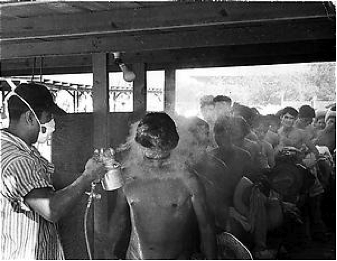Featured Document: Bracero Workers
March 30, 2011
nn

In recognition of Labor Day and our professional development program focus on immigration, we’ve selected a document from our collection of material on the Bracero Program. Between 1942 and 1964, millions of Mexican agricultural workers entered the U.S. to work as farm laborers through the government-sponsored Bracero Program. This photograph of Department of Agriculture personnel spraying braceros with the now-banned pesticide DDT as they arrive at the U.S. processing centers reveals the workers’ experience of being treated like livestock.
nn
nn
As bracero worker Rigoberto Garcia Perez recalled, “Thousands of men came every day. Once we got there, they’d send us in groups of two hundred, as naked as we came into the world, into a big room, about sixty feet square. Then men would come in in masks, with tanks on their backs, and they’d fumigate us from top to bottom. Supposedly we were flea-ridden, germ-ridden. No matter, they just did it.”
nn
The Bracero Program was the largest and most significant U.S. labor guest worker program of the twentieth century with more than 4.5 million workers coming to the U.S. It exemplified the dilemma of immigrant workers-wanted as low-cost laborers, but unwelcome as citizens and facing discrimination. Supporters of the program viewed it as an opportunity for Mexican nationals to make a living and improve the conditions of their families. But the migrant labor movement, including Cesar Chavez of the United Farm Workers, opposed the program because of its exploitation of workers. Mexican agribusinesses and agricultural unions also opposed the program on the grounds that it not only drained the Mexican economy of agricultural workers but allowed the U.S. to develop a surplus of crops, such as cotton, that then hurt the price of Mexican cotton on the market. One profound effect of the program was its influence on Mexican American settlement patterns in the U.S. and the shared experience of many Latino families whose ancestors were involved in the Bracero Program.
nn
Don’t forget to visit Now and Then: An ASHP blog for updates on ASHP/CML events and other staff musings.
